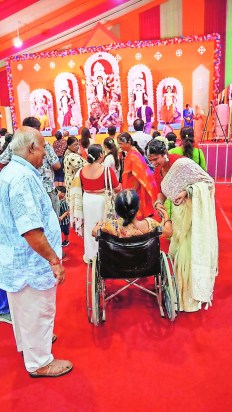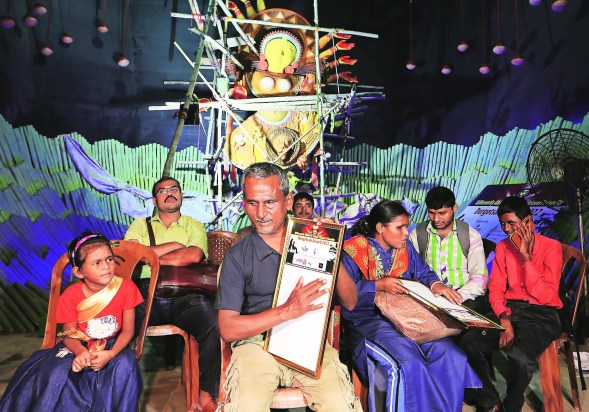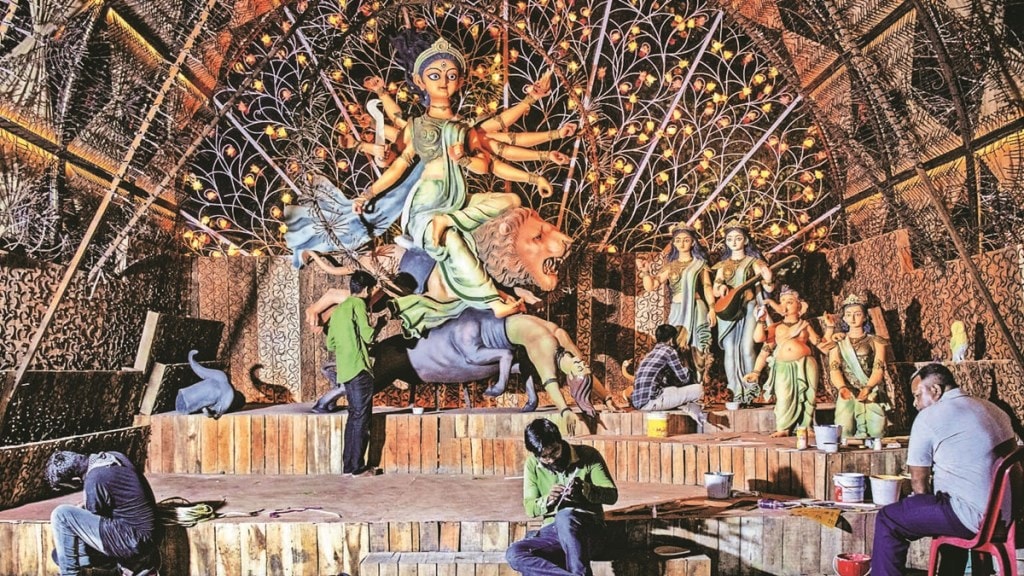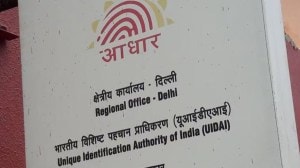Durga Puja commit-tees are experimenting with unique ways to make the festival more accessible. From wheelchair ramps at pandals to medical kiosks and biodegradable decorations, the initiatives are embracing a wider spectrum of visitors, symbolising not just the victory of good over evil but also inclusivity and sustainability.
The conversation is now reaching a new inflection point. An example is the cultural non-profit, massArt, which is expanding its annual art preview this year to explicitly include seniors and persons with disabilities.
The organisation, founded in 2022, has always positioned Durga Puja as the world’s first public art show staged at night. Now, in partnership with Unesco, the West Bengal government and IIT-Kharagpur, it is pushing accessibility into the mainstream of puja organisation. The scale is significant, according to massArt, the industry employs more than 200,000 artisans, supports 2,300 sites and attracts over 25 million visitors each year.
Its fourth preview show, to be held from September 18 to 22, will allow pass holders to access 24 community pujas and one family puja before crowds descend. The passes are vetted through online applications requiring proof of age or disability certificates. Once admitted, visitors will receive pick-up and drop services, ramps, and resting areas.
Innovating locally
While massArt has made the issue visible at scale, local committees across India have long experimented with models of inclusivity. In New Delhi’s CR Park, the Co-operative Ground Puja has been running special services for over a decade. “What’s happening in Bengal now has been done here for the past 10 years,” says Vivek Bhattacharjee, its general secretary.
The committee, which celebrates its diamond jubilee this year, provides free e-rickshaw pick-up and drop for senior citizens, wheelchair-friendly grounds, medical kiosks and special pushpanjali arrangements for those unable to stand in long queues. “Our ground is wheelchair friendly and provides special prayer and eating arrangements. We have medical kiosks and ensure seating arrangements for the needy across the three days,” Bhattacharjee adds.
Sustainability is also central. “Our pujo is totally eco-friendly, from idol-making by Bengal artists to the bhog plates we use,” he says. Drones and LED screens help monitor crowds.
Nearby, another CR Park committee has taken a more artistic turn. The B-Block Puja this year is sculpting its Durga idol entirely in natural clay, with subtle gilded highlights derived not from paint but from soil-gold textures. “All decorations are from natural, biodegradable materials, such as jute, terracotta, dry hay, wood and cow dung patties,” says veteran member Ashish Shome. Gold foil will be used sparingly to accentuate contrast rather than overwhelm. The committee is also running workshops for children and visitors to build miniature idols, and has created a panel paying tribute to the kumors, the traditional idol-makers of Kumortuli in Kolkata. The committee also educates visitors on eco-friendly immersion and soil conservation.
In Bengaluru, the Kodichikkanahalli Sarbojanin Utsav Committee (KSUC) takes yet another approach. Its 14-year-old puja combines cultural preservation with social outreach, supporting schools, orphanages and old-age homes. “Our pujo is about keeping the culture alive for our members, but also about extending its spirit to those in need,” says Balai Saha, its secretary.
Saha lists a catalogue of initiatives — distributing shoes and bags to government schoolchildren, supplying filters and medicines to old-age homes, supporting HIV-positive children with nutrition and medicines, and arranging six months of uninterrupted oxygen back-up for destitute patients referred by the police. “This year, we are identifying two or three anganwadi schools, planning to donate plastic chairs, toys, dresses and shoes,” he says.
Sudip Bhowmik, president of KSUC, adds that their donations have ranged from water purifiers, UPS systems and table fans to food supplies such as rice, lentils and oil. “We prefer to donate directly and ensure continuity. We donate about 90% of what we raise, and keep 10% as a buffer for the following year,” he adds.
Focus on care
The visibility of these local innovations has helped spur more formal campaigns. SilverGenie, an elder-care company, recently launched #DurgaPujoWithCare, aimed at ensuring that seniors and persons with disabilities can safely participate.

“At SilverGenie, our mission is to challenge the misconception that seniors, or our Genie members, should avoid festive crowds,” says founder and CEO Poulomi Bhattacharya. “We believe that age or mobility should never stand in the way of celebrating something as vibrant as Durga Puja. With the right planning, support, and safety measures in place, seniors can experience the joy of the festivities fully and comfortably,” she adds.
Bhattacharya’s team combines itinerary planning and WhatsApp-based crowd-density updates with on-ground concierges who carry first-aid kits, provide wheelchair support and liaise with local volunteers. “Our Kolkata-based team handpicks pandals that are mobility-friendly, plans routes to minimise crowding, arranges VIP access at select locations and ensures seating is nearby.
Concierges remain by members’ side during rituals like the Dhunuchi dance or immersion, ensuring safe participation,” she adds.
The push towards accessibility has also been formalised through Narayani Namastute, an initiative that is now in its eighth season. The group recognises Durga Puja committees across India and overseas that integrate sustainability and inclusivity into their organisation. “The foremost hurdle is addressing traditional mindsets that resist change,” says Mithu Chatterjee, its co-founder, adding: “Awareness and education are vital, as is financial support for smaller pujas. Globally, the task is balancing cultural authenticity with sustainable and accessible practices.”

His group’s judging process rewards puja pandals that make provisions for vulnerable groups. “We acknowledge special arrangements for the elderly, physically challenged and expecting mothers,” she explains. “We encourage puja committees to create accessible pathways, seating areas, and to employ trained volunteers, sign-language interpreters and sensory-friendly zones. Children are equally at the centre of our celebrations, with safe play areas and activities,” she adds.
State scaffolding
If committees and NGOs are innovating from below, the state has gradually added scaffolding from above. In 2018, West Bengal CM Mamata Banerjee launched a grant programme that gave Rs 10,000 to each registered puja committee. This year, she announced a 30% hike, raising the annual grant to Rs 1.1 lakh per committee, covering more than 40,000 pujas across the state.
Banerjee also underscores the need for a safe and inclusive Puja experience. She issues detailed guidelines for committees, ensuring CCTV surveillance, drone monitoring, watchtowers, women-friendly arrangements, and separate entry and exit points at pandals. The state has earmarked 300 ambulances, procured from her MPLAD fund, that can be deployed during the festivities.
What emerges from these layered initiatives, massArt’s art preview, SilverGenie’s concierge services, Narayani Namastute’s awards, is an expansion of its scope. From Kolkata’s labyrinthine lanes to diaspora pandals in New Delhi and Bengaluru, puja committees are reimagining their role, not just as cultural stewards but as facilitators of access, safety and sustainability.








